Hither Came Conan: Keith J. Taylor on “Red Nails”
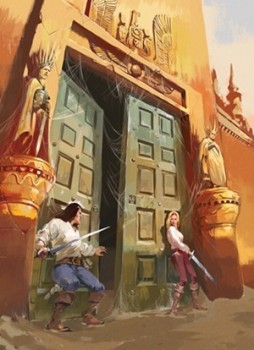
Welcome back to the latest installment of Hither Came Conan, where a leading Robert E. Howard expert examines one of the original Conan stories each week, highlighting what’s best. Keith Taylor talks about “Red Nails.” It was the last Conan story written by Howard, who was moving on from fantasy. Read on!
“Red Nails” happens to be one of this writer’s favourite Conan stories, of that particular length, along with “People of the Black Circle” and “The Black Stranger” (which REH also wrote as a Black Vulmea pirate yarn, “Swords of the Red Brotherhood”).
Aside from their general length, they have other elements in common. One is the usual rip-roaring, headlong action, inventiveness, and raw violence which Howard’s name on a story guaranteed. Another is a pattern of shifting alliances and double- or triple-crosses. Yet another is a furious resolution at the end, involving the gory deaths of some of the main players.
The background against which the story unfolds in “Red Nails,” the mad, claustrophobic lost city of Xuchotl, is almost a major character in itself. For a contrast, at the beginning, Howard opened his story in the natural world outside, an immense forest of ancient trees, rocky crags and wild beasts. He introduces his protagonists there, Conan and the Aquilonian pirate, Valeria of the Red Brotherhood. Valeria has killed a mercenary officer who tried to rape her, and before that, had to jump overboard from a pirate ship because “Red Ortho wanted to make me his mistress.”
Conan has followed her south from the mercenary camp with that identical idea. They are almost about to come to sword-strokes when a dragon kills their horses and interrupts the scene – described by Howard as “at once ludicrous and perilous.”
The dragon is interesting. In general design it’s like a stegosaurus, right to the spiked tail, armour plates along the spine, and “absurdly short legs.” The head, though, is not tiny but decidedly big, its vast gape armed with rows of carnivore fangs. It turns out later that the dragon and its kind had in fact been extinct for an epoch or so, and nothing remained of them in the forest but their bones, until the magicians of Xuchotl resurrected them, “clothed in flesh and life.”
Killing the dragon – which Conan does with a makeshift poisoned spear driven into the soft angle of its jaw, from the relatively safe vantage of a high rock – makes a vivid, dramatic episode in itself, but as usual with REH stories, that’s just the curtain-raiser.
Passing from the wilderness into Xuchotl, Conan and Valeria find themselves in a weird, hermetically sealed little world, the entire city built under continuous roofs on four levels, with no open streets or plazas, just endless chambers, halls and corridors, made of jade, marble and other minerals, lit by the eerie, deathless light of glowing fire-jewels.
Beneath its lowest tier lie the ancient, haunted catacombs where at least one monster lurks, and sorcerous devices and weapons may be found by anyone reckless enough to go searching there. It isn’t even necessary to raise crops or herds in Xuchotl; one bit of knowledge that survives among its people is the art of growing food that obtains its nourishment from the air. Therefore, it’s not even necessary to do something as normal and (literally) down-to-earth as work the fields to survive.
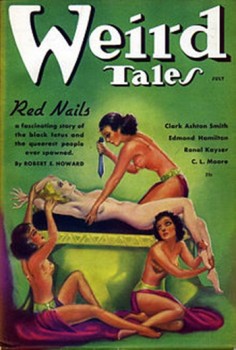
Aside from the environment’s being claustrophobic and unreal, it also contains horrors like the skull of an ancient wizard which induces madness merely to see, and a set of pipes whose music sends people into homicidal frenzies. Being born and raised in Xuchotl would be a fate that pretty much ensured insanity. Valeria describes the place as “this crazy city,” succinctly and truly.
The inhabitants of Xuchotl when Conan and Valeria arrive are not its original builders. These are extinct. The squatters are a race who seem like a Hyborian Age version of Meso-Americans. They are generically called Tlazitlans and have names like Techotl, Xatmec and Olmec.
(In passing, the name “Tlazitlan” sounds much like “Aztlan”, the legendary country from which the Aztecs claimed to have come origin- ally. Howard, a voracious reader, with a strong interest in the lore of the Southwest, would surely have known that.)
Since coming to Xuchotl they have divided in two factions, each barricaded into its own stronghold at opposite ends of the city, locked in a demented, mutually suicidal feud.
“It was a ghastly unreal nightmare existence these people lived … caught together like rabid rats in the same trap, butchering one another through the years, crouching and creeping through the sunless corridors to maim and torture and murder.”
Not amazingly, they are dying out. No children have been born among them for years. The feud obsesses them so completely that they do not care. It’s a situation reminiscent of the murderous Southwestern feuds REF depicted in stories like “The Valley of the Lost” and “The Man on the Ground.” In the latter, the protagonist is so consumed by hate that he doesn’t notice he is dead until after he has killed his enemy.
So much for the setting and the situation. The characters Conan and Valeria meet in Xuchotl are as bizarre. Olmec, prince of the Tecuhltli faction, is a Minotaur-like figure, huge, massive and powerful, brutish but cunning, with a thick blue-black beard falling over his chest. He’s treacherous, lustful, cruel, and a villain in general.
Olmec is cruder and less intelligent than his co-ruler in Tecuhltli, the quasi-immortal witch, Tascela. Nor does she share Olmec’s – and the rest of their faction’s – mad obsession with the feud. She is cynically unconcerned with its waste and sadistic monstrousness, and seems to regard her sojourn in Xuchotl, decades long though it has been, as merely a phase in her existence. We’re told that “Valeria found her indifferent callousness more repugnant than Olmec’s naked ferocity.”
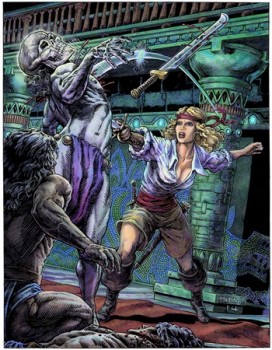
Valeria has been somewhat slighted in this review so far, and slighting Valeria of the Red Brotherhood is unsafe. Even if you’re Conan. Valeria is a hellion to stand with that other REH sword woman, Agnes de Chastillon. When Conan follows her through the vast forest and asks her, “Haven’t I made my admiration for you plain?” she answers scornfully, “A stallion could have made it no plainer.”
When the confrontation goes as far as Valeria drawing her sword, and he asks if she wants him to take “that toy” away from her, she tells him these are nothing but big words, and no man breathing can disarm her bare-handed. Conan has to acknowledge that as the simple truth.
When she first encounters the madmen of Xuchotl in a desperate three-to-one fight (and the women, when she meets them, turn out to be just as crazy and cruel), she splits the skull of the first in a hot second, then runs another through the belly, but he doesn’t die at once and Valeria is hard pressed for a while. Finally, she gets an advantage, spits “Dog of hell!” and cuts off the last maniac’s head. After that she hurls it across the room.
Techotl, the man she rescues from his foes on that occasion, seems less insane than the rest. He conceives an admiration for the strangers that brings a touch of normal warmth to his soul, lacking in his fellows, whose lives are “cold, loveless and altogether hideous.” He watches over the outsiders, tastes their food for them, and in the end suffers the usual fate of minor spear-carriers.
Allied with the Tecuhltli faction – mainly because they met them first, and as Conan says, “I’d as soon kill Xotalancas as anybody,” – the adventurers discover that the other side has an advantage in magical devices and techniques. It turns out, though, that they are fewer than their enemies, and they stake everything on a desperate onslaught. It’s probably not a spoiler to reveal that it fails. Then the betrayals begin. Olmec and Tascela double-cross Conan and Valeria. After that, they double- cross each other. However, Conan isn’t dead, as Olmec thinks.
Tascela has taken possession of Valeria, by this time, for her own purposes. Valeria had never liked the way Tascela looked at her, but she suspected Tascela of being Sapphic. Instead, it transpires that Tascela means to renew her youth by sacrificing Valeria, and with Valeria on the altar, Tascela gloating with a knife in her hand, Conan caught in a man-trap and their only real friend in Tecuhltli dead, things are looking bad.
However, a weirdo even more insane than the rest intervenes at the last minute (he’s been referenced or hinted at several times, so this isn’t cheating on Howard’s part) with a deadly electrical wand, and starts killing everybody. The finale makes the last act of Hamlet look like a Sunday school picnic. As Conan observes with some understatement, “It’s been a hell of a night!”
“Red Nails” first appeared as a serial in Weird Tales, over four issues (July – October) in 1936. No review of it would be complete without a mention of the legendary Margaret Brundage’s cover for July, depicting Valeria naked on the altar with Tascela about to slay her – a fairly kinky tableau even by today’s standards.
The story was reprinted in The Sword of Conan in 1952, then by Lancer Books and Sphere Books in Conan the Warrior in the 1970s. Marvel Comics produced a graphic version of “Red Nails” in 1973, scripted by Roy Thomas and brought to life by the superb art of Barry Windsor-Smith. It would have taken Smith to do justice to the story, and he did.
“Red Nails” won’t be out of print, or cease to be sought after, for a long while yet.
From the Dusty Scrolls (Editor comments)
With Red Nails, it seems that Robert E. Howard was done using sword and sorcery to expound on barbarism vs. civilization. In a letter to HP Lovecraft (not Clark Ashton Smith, as has been identifed before), he wrote:
“The last yarn I sold to Weird Tales – and it may well be the last fantasy I’ll ever write – was a three part Conan serial which was the bloodiest and most sexy weird story I ever wrote. I have been dissatisfied with my handling of decaying races in stories, for the reason that degeneracy is so prevalant in such races that even in fiction it can not be ignored as a motive and as a fact if the fiction is to have any claim to realism. I have ignored it in all other stories, as one of the taboos, but I did not ignore it in this story. When, or if, you ever red it, I’d like to know how you like my handling of the subject of lesbianism.”
Finally, in his last Conan story, Howard created a female character who could hold her own against Conan. Sort of. Valeria of the Red Brotherhood is the (in my opinion) the only female lead who could have starred in her own series. She is a first class fighter, fiercely independent, and more than capable of handling herself. Though, Conan saves her life not once, but twice in the story. And she needs to be saved another time by her would-be-slayer. It seems that Howard simply couldn’t resist hanging the ‘damsel in distress’ tag on heroines.
I’m going to write an essay on the moral challenges of Conan. And his first encounter with Valeria in this story is going to be included.
Roland Green’s Conan and the Gods of the Mountain begins immediately after the end of “Red Nails.” With the natives being of a mesoamerican styling, it varies from the usual jungle native/Kushite/similar tropes used in various stories. I’ve read worse Tor pastiches, but also, quite a few better ones. I didn’t think it worth re-reading for this week’s essay. The very end does show that Valeria was ready to acquire a ship and continue traveling with Conan. But he has other ideas:
“Buy you (not us) a ship. Two of us on one ship would divide the crew. I’m for turning landsman, anyway, until the Barachans have forgotten the name of Conan the Cimmerian.”
An animated version of “Red Nails,” starring Ron Perlman and with art from Mark Schultz, never came about.
Marvel’s Savage Tales covered this story in issues 2 and 3.
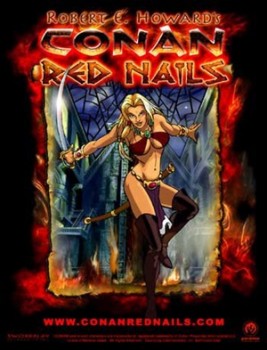
Prior Posts in the Series:
Here Comes Conan!
The Best Conan Story Written by REH Was…?
Bobby Derie on “The Phoenix in the Sword”
Fletcher Vredenburgh on “The Frost Giant’s Daughter”
Ruminations on “The Phoenix on the Sword”
Jason M Waltz on “The Tower of the Elephant”
John C. Hocking on “The Scarlet Citadel”
Morgan Holmes on “Iron Shadows in the Moon”
David C. Smith on “The Pool of the Black One”
Dave Hardy on “The Vale of Lost Women”
Bob Byrne on Dark Horse’s “Iron Shadows in the Moon”
Jason Durall on “Xuthal of the Dusk”
Scott Oden on “The Devil in Iron”
James McGlothlin on “The Servants of Bit-Yakin”
Fred Adams on “The Black Stranger”
Stephen H. Silver on “Man Eaters of Zamboula”
Next week, it’s Ryan Harvey on “Hour of the Dragon.”
The award-winning Keith Taylor, who has appeared prolifically in Weird Tales, is author of the five-novel Bard series, about the Irish bard Felimid mac Fal. He also cowrote two Cormac mac Art books with Andrew Offutt. I like his in-depth look at Black Vulmea.
 Bob Byrne’s ‘A (Black) Gat in the Hand’ was a regular Monday morning hardboiled pulp column from May through December, 2018.
Bob Byrne’s ‘A (Black) Gat in the Hand’ was a regular Monday morning hardboiled pulp column from May through December, 2018.
His ‘The Public Life of Sherlock Holmes’ column ran every Monday morning at Black Gate from March, 2014 through March, 2017 (still making an occasional return appearance!).
He also organized Black Gate’s award-nominated ‘Discovering Robert E. Howard’ series.
He is a member of the Praed Street Irregulars, founded www.SolarPons.com (the only website dedicated to the ‘Sherlock Holmes of Praed Street’) and blogs about Holmes and other mystery matters at Almost Holmes.
He has contributed stories to The MX Book of New Sherlock Holmes Stories – Parts III, IV, V and VI.
And he is in a new anthology of new Solar Pons stories, out now.
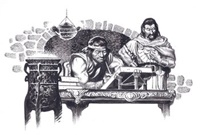
“It was a ghastly unreal nightmare existence these people lived … caught together like rabid rats in the same trap, butchering one another through the years, crouching and creeping through the sunless corridors to maim and torture and murder.”
Sounds like Chicago.
Thank you, Mr. Taylor.
That was a penetrating look at one of REH’s best and for me, one of his most disturbing stories. I don’t think I’ve ever read any story that describes the madness and ferocity of a blood feud better than Red Nails.
Coming to this one late (I’m on vacation and not online as much as usual). A good summary of the story and its qualities without really stressing its merits. But I’m not sure Taylor really makes a conclusive case for “Red Nails” as the best Conan story.
For me, it’s always been something of a one-note tale, though Taylor does an excellent job of pointing out all the different things that are really going on in it, particularly the character of Valeria. (Though I never really understood how he could make a woman so obviously able to take care of herself and then somehow manage to … not do it.)
That said, this is still Howard bending all his powers to a single purpose or thesis, and has never seemed as well-rounded as the other longer Conan tales. I would place “The People of the Black Circle,” in particular, a cut above it.
Another excellent post from Mr. Taylor.
While I agree that REH probably drew some/most of the inspiration for the situation in Xuchotl from feuds like the Lincoln County War, I’ve always thought there were a few similarities to Hammett’s RED HARVEST (1929). I mean, if REH wrote Conan saying, “This damned city’s getting to me. If I don’t get away soon, I’ll be going blood-mad like the Tlazitlans,” I doubt anyone would bat an eye. Yet, I only changed threee words in that quote from what the Continental Op actually says in RED HARVEST.
Nonetheless, it’s probably coincidence.
Mr. Taylor, I enjoyed your tales of Kamose the sorcerer. It was refreshing to read sword and sorcery with a protagonist on the latter half of the ledger.
I have been eagerly awaiting, yet somehow dreading this instalment. Awaiting as Red Nails remains hands down my favourite Conan story. Dreading because this is the last one.
Red Nails was I think the first Conan short story I read, preceded only by hour of the Dragon. I still remember being unable to put the book down.
Excellent synopsis Mr Taylor. Although have to agree a little with Brian Kunde that you maybe undersold it a bit.
I read the story again seven years ago, and wrote some notes:
Reading it today for perhaps the third time, I was struck by the pictorial quality of Howard’s prose in the first few paragraphs, and here and there later on.
The story seems to have three plot elements, and they aren’t very integrally related.
a.The dragon-dinosaur in the jungle accounts for a good fifth of the story’s length. Its attack and its demise are told with some attention to detail. I was reminded of Rider Haggard’s way of including a lion-hunt scene early in an Allan Quatermain story before we settle down to the business of a lost civilization. Howard eventually suggests that the dwellers in the lost city believe (most of them) that the jungle is full of these creatures, from which there would be no escape if they ventured out, but given their mad murderousness towards one another, the device of the “myth” of a jungle full of dragons doesn’t seem necessary, or at least doesn’t seem fully adequately accounted for. The dragon gives Conan an adventure to start the story off with a bang and allows Howard time to develop the relationship between Conan and Valeria.
b.The story of the Hatfields and McCoys — excuse me, Xotalancas and Tecuhltli — is the major plot element. Some of the exposition regarding how they came to be there, how they wage their war, etc. is clumsy. Incidentally I wonder if anyone has explored the possibility that Howard was influenced by the feud between the Grangerfords and the Shepherdsons. The feud accounts for much of the bloodletting in this extremely violent story. Howard simply has it that the two (formerly three) factions are all mad. They have stopped reproducing themselves and simply engage in raids. They seem, then, puppet-like, and the reader must conclude it is the author pulling the strings. Since Howard doesn’t provide much of a justification, in terms of the fiction, for the endless feuding, and since we hardly care about any of the characters except Conan and Valeria, we readers are left to derive what interest we can simply from the descriptions of the violence for its own sake.
c.There’s also the plot about how Tascela has kept herself beautiful for so many centuries through the sacrifice of other women. This element just seems plopped in to the story to add to the weirdness. Howard hasn’t imagined it in any depth; it seems to be there primarily, first, to give him an excuse for describing one beautiful woman staring at another, which he seems to find intriguing in its own right, and, second, to provide a climactic scene with Conan coming to the rescue. So Howard has the idea of an “immortal” witch-queen but hardly uses it. This seems eminently and culpably pulpish to me: often pulp fiction contains elements of fantastic romance that a gifted writer could really make something of (e.g. Haggard in She), but in the hands of the pulp writer they are not well developed. There’s little of the truly impressive in the rendering of the unpleasant Tascela.
One wonders if Howard couldn’t have got a lot more bang out of his materials, if he was determined to use all of them, if he’d suggested, for example, that the madness of the two factions was due in part to the strain of living, year after year, with this horrible, age-defying, beautiful presence in their mortal midst. Maybe even some connection between Tascela, who is so ancient she can’t remember her origin [I think — I couldn’t find the passage on a quick check], and the ancient dragon-dinosaur, could have been developed.
I was struck by how pulpish some of Howard’s writing was, including terribly stagy dialogue (“‘Tolkemec! … You have dwelt for twelve years in darkness! Twelve years among the bones of the dead! What grisly food did you find? What mad travesty of life did you live, in the stark blackness of that eternal night?'”) and blatant verbal clichés. “Conan saw red.” The dragon “snapping off saplings as if they had been toothpicks.”
Writing such as this isn’t conducive to the dignity of the best fantasy — it is writing that the reader *needs not to pay close attention* to: “‘What are you waiting down there for, you misbegotten offspring of questionable parents?’ was one of his more printable queries.” “…the monster was wallowing like a dog with pepper in its eyes.” Conan’s use of “Sure!” where something like “Aye!” would’ve been more admissible.
In my remarks, then, I have tried to say something not just about “bad writing,” but about bad reading. A story must be criticized if it solicits bad reading, that is, solicits inattention to the words as well as the ideas and images, etc. I don’t say that the writing in “Red Nails” is bad all the way through, but that there is quite a bit of bad writing in it.
19 June 2012
“Needs not to pay attention to” is awkward, but I hope readers will understand the expression. It seems that, for Howard to captivate the reader, the reader must not pay close attention to the words.
An excellent example of that kind of story is Connell’s “The Most Dangerous Game.” The reader *needs* (if the story is to succeed) to read quickly, not attending closely to what he or she is reading. If the reader does, questions arise: when Zaroff and Rainsford eat their gourmet dinner, who cooked it? Who installed the deceptive beacon lights? And so on. Howard was a writer like this.
We who comment here at Black Gate are often people who discovered a given author when we were youngsters, and when we reread, there’s the pleasure of fond associations, especially if we have hung on to the same copies we owned so many years ago. The danger here is that rereading becomes a somewhat unwholesome wallow in nostalgia (and also a deliberate self-blinding to objectionable writing); at any rate, when indulging in nostalgia, we might not really be reading the story that is in front of us. Isn’t that bad reading? One simple way to counter this might be to reread a favorite from youngsterdom in a different book or, if available, as an online text. I’m not saying that *any* form of nostalgia is illicit, but let’s distinguish such sensations from those rightly attributable to a story itself.
Dale Nelson
Fun re-cap, Keith, but where’s the persuasive argument for ‘Best of’?
Dang, that animated flick could have been something to see!
As to your damning commentary, Major, all I’ll say is that I agree there are many tales successful only if “read quickly, not attending closely to what he or she is reading.”
Jason – I’ve mentioned before, the ‘best of’ approach was just an overview for the series idea. The general gist was to pull out noteworthy elements of every Howard story. They all have some. Of course, some more than others!
So, the style varies.
Dale – It’s generally agreed that the Lincoln-County War (mentioned in Deuce’s comment) influenced Howard for this story. He talked about it at length, around this time, in letters to Lovecraft.
Wait! This is the last entry in the “Hither Came Conan” series???
NO!!!!!
No, it’s not. You have to tolerate me next week.
I would like to see this series continue, maybe as a phase 2, covering some of the pastiche/rehash stories. While no doubt this would put some people’s nose out of joint I remember being entertained by the likes of Curse of the Monolith, The Snout in the Dark and The Thing in the Crypt.
*Ryan Harvey*
Whew! What a relief!
And when was the last time someone said that to you, eh?
John – I had to juggle the schedule some. That just referred to ‘Red Nails’ being the last written story.
There are still entries coming from me, Patrice Louinet, Deuce Richardson, Mark Finn, Woelf Dietrich, Jeff Shanks, and Ryan Harvey (who is, indeed, up next week).
You can see who is assigned what from the second link in the ‘Previous Posts’ above.
And, last April, when I was trying unsuccessfully to recruit Erik Mona to participate, he suggested that I should try a series talking about the best de Camp/Carter pastiches. So, that idea is out there!
I think I like those stories more than most Conan fans I know. I even did this post and this post on pastiches.
But probably not enough to put in the time and energy to organize and run such a series.
It is possible there will be a similar series covering Solomon Kane, in 2021. It’s on my ‘Maybe’ list.
“Valeria of the Red Brotherhood is the (in my opinion) the only female lead who could have starred in her own series”
I guess you have never read about Bêlit of the Black Coast. Or Yasmela of Vendhya
Terry – Since we haven’t done ‘Queen of the Black Coast’ yet, I forgot about Belit.
Other than hiring Conan at a god’s behest, I don’t remember Yasmela doing much more than being a maiden in distress.
I do talk about her a bit in a follow-up essay coming for ‘Black Colossus.’ She appears in a couple of pastiches.